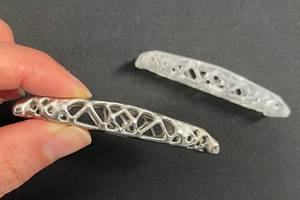Desktop Metal Expands Metal Portfolio with Chromoly Steel
Desktop Metal expands its metal portfolio with the launch of 4140 Chromoly steel for industrial applications. Studio System users will now be able to 3D print couplings, connecting rods, pump shafts, pinions, worm gears and more.
Desktop Metal has launched 4140 chromoly steel for the Studio System, an office-friendly metal 3D printing system for prototyping and low volume production. Said to be a versatile chromoly steel, 4140 is characterized by its toughness, high tensile strength, and abrasion and impact resistance, making it a key all-purpose steel for industrial applications.
“Desktop Metal is broadening its materials portfolio to include 4140 chromoly steel, enabling designers and engineers to print a broad variety of critical industrial applications, such as couplings, forks, pinions, pump shafts, sprockets, torsion bars, worm gears, connecting rods, and fasteners,” says Ric Fulop, CEO and co-founder of Desktop Metal. “Now, teams around the world will be able to leverage the Studio System to iterate quickly on 4140 prototypes and ultimately produce end-use, customer-ready parts faster and more cost-effectively.”
Early applications of 4140 parts printed with the Studio System illustrate the benefits across a variety of industries, including automotive, oil and gas, pumps and hydraulics, agriculture and defense, among others.
Automotive: Connecting Rod
A key component in combustion engines, connecting rods are used to connect a piston head to a crankshaft. During combustion, connecting rods experience significant loads and must endure high temperatures, so functional testing must be conducted using metal parts. 4140 is a key material choice for this application as it can withstand the high temperatures and mechanical stresses experienced by connecting rods. With the Studio System, users have the ability to create functional prototypes in a matter of days, and then rapidly iterate on those designs. This ensures engineers can develop efficient components and validate how they perform before committing to the manufacture of potentially millions of parts via casting or forging.
Agriculture: Mechanical Coupling
A common component in many types of machinery, mechanical couplings are used to connect two rotating parts. Where off-the-shelf parts don’t suffice, however, custom couplings must be fabricated for the specific application - a process that can be both time-consuming and expensive. The complex geometry and fine features of this particular coupling, used to attach a motor in a hopper metering system, make it a difficult and expensive part to machine. With the Studio System, the design team is able to produce a prototype of this part in a matter of days, then test its functionality in the machinery where it will be used. Printing this part allows engineers to create working models of machinery faster and with less expense. By printing in 4140, the material’s high torsional strength also enables it to stand up to the stresses couplings must withstand on a day-to-day basis.
Industry: Sheet Metal Tooling
Press brake tools are used to create bends in sheet metal with a wide range of applications - from the production of heavy-duty metal parts, to electronics enclosures. This tool in particular is used to create a custom bend angle in aluminum. The long lead times and increased costs that accompany custom tooling make it impractical for smaller or specialty jobs. Now 3D printing with the Studio System allows shops to quickly create custom tools like this one and take on specialty jobs, while still keeping cost per-part low. 4140 is an ideal material choice for the production of this press brake tool due to its toughness and resistance to impact.
4140 is the latest addition to the Studio System materials library, which also includes H13 tool steel, and 316L and 17-4 PH stainless steels. Desktop Metal plans to introduce additional core metals to its portfolio, including superalloys, carbon steels and copper.
Related Content
VulcanForms Is Forging a New Model for Large-Scale Production (and It's More Than 3D Printing)
The MIT spinout leverages proprietary high-power laser powder bed fusion alongside machining in the context of digitized, cost-effective and “maniacally focused” production.
Read MoreThis Year I Have Seen a Lot of AM for the Military — What Is Going On?
Audience members have similar questions. What is the Department of Defense’s interest in making hardware via 3D printing over conventional methods? Here are three manufacturing concerns that are particular to the military.
Read MoreDMG MORI: Build Plate “Pucks” Cut Postprocessing Time by 80%
For spinal implants and other small 3D printed parts made through laser powder bed fusion, separate clampable units resting within the build plate provide for easy transfer to a CNC lathe.
Read MorePossibilities From Electroplating 3D Printed Plastic Parts
Adding layers of nickel or copper to 3D printed polymer can impart desired properties such as electrical conductivity, EMI shielding, abrasion resistance and improved strength — approaching and even exceeding 3D printed metal, according to RePliForm.
Read MoreRead Next
Alquist 3D Looks Toward a Carbon-Sequestering Future with 3D Printed Infrastructure
The Colorado startup aims to reduce the carbon footprint of new buildings, homes and city infrastructure with robotic 3D printing and a specialized geopolymer material.
Read MorePostprocessing Steps and Costs for Metal 3D Printing
When your metal part is done 3D printing, you just pull it out of the machine and start using it, right? Not exactly.
Read MoreBike Manufacturer Uses Additive Manufacturing to Create Lighter, More Complex, Customized Parts
Titanium bike frame manufacturer Hanglun Technology mixes precision casting with 3D printing to create bikes that offer increased speed and reduced turbulence during long-distance rides, offering a smoother, faster and more efficient cycling experience.
Read More




















